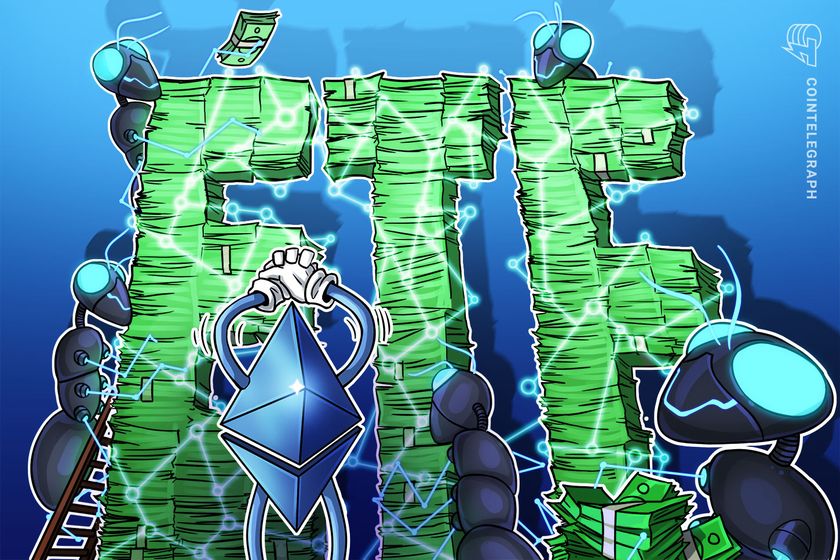3 bullish catalysts for Ethereum price in June

A confluence of technical and fundamental indicators suggests that Ethereum could maintain its monthly bullish outlook despite the latest price correction.
As of June 1, Ether (ETH) has dipped by more than 40% after establishing a record high of $4,384 in May.
The major move downhill in the world’s second-largest cryptocurrency by market cap has prompted many analysts to predict additional declines. For instance, Clem Chambers, chief executive of financial analytics portal ADFVN.com, sees the recent ETH/USD plunge as reminiscent of the beginning of 2018’s crypto crash that preceded a 24,000%-plus bull run.

Ether surged by more than 4,500% after bottoming out in March 2021 before it wiped off almost 60 percent of those gains in just two weeks of trading in May 2021. Chambers noted that the ETH/USD rate remained at the risk of declining lower, adding that it might take “three and a half years’ time” for the pair to reclaim its all-time high.
Akash Girimath, a financial correspondent at FXStreet, also noted the ETH/USD rate could fall to $1,200, citing Santiment’s 365-day Market Value to Realized Value (MVRV) model. The index measures the profit/loss status of investors that purchased ETH in the past 12 months.

The metric’s readings declined from 120% to 57% since May 11, noting that the number of investors with profit-making ETH portfolios declined following the May 19 price crash. In turn, that increased the likelihood of other investors — those that remain in profits — to unfold their ETH positions, so they minimize their downside risks in the event of an extended price decline.
But amid the pessimistic scenarios, there also emerged narratives that supported the prospects of an early Ether price recovery.
Major network upgrade in July
Investors still have a month to adjust their bias toward Ethereum as the blockchain project prepares for its major network upgrade in July.
Dubbed as Ethereum Improvement Proposal 1559, or EIP-1559, the update expects to do away with the Ethereum network’s major issue: higher transaction fees. It would do so by replacing Ethereum’s “first-price-action” fee model with a base network fee that would fluctuate based on network demand.
Vitalik Buterin and Eric Conner, the author of EIP-1559, anticipates that the protocol would create a more efficient fee market and simplify gas payment process for clients and decentralized application software.
Meanwhile, EIP-1559 also proposes to burn transaction fees, thereby introducing deflation to the Ethereum ecosystem. Its impact on ETH prices could be similar to how Bitcoin halving impacts BTC/USD rates — lower supply against higher demand leading up to higher prices.
Nevertheless, some believe that EIP-1559 is not bullish for ETH as it appears to be. Kyle Samani, managing partner at Multicoin Capital argued that if the bids for ETH/USD goes up, Ethereum would still become expensive to use.
Many people view EIP 1559 as bullish for Ethereum. However, @KyleSamani and @kaiynne think adopting EIP 1559 could have a few pitfalls — such as unit bias and higher gas fees (since ETH would be more expensive).
What do you think? Are you worried EIP 1559 could hurt Ethereum? pic.twitter.com/tbUTsrNWSd
— Laura Shin (@laurashin) May 26, 2021
OKEx analyst Rick Delaney also appeared cautious in calling EIP-1559 an all-and-all bullish event for ETH. Nevertheless, he added that the proposal would make Ethereum attractive for wealthier investors.
“A potentially deflationary ETH — thanks to EIP-1559’s fee-burn mechanism — may enhance the asset’s appeal among the planet’s wealthiest investors,” Delaney said in April. “Similarly, the launch of staking as part of an ongoing upgrade to Ethereum 2.0 appears to be contributing to the current rising demand.”
Decreasing amount of Ether on exchanges
A recent Glassnode data shows that ETH continues to flow out of cryptocurrency exchanges even after its 40% price crash.
The “Ethereum: Balance on Exchange — All Exchanges” metric showed that ETH reserves held across trading platforms’ hot wallets dropped from 13.9 million on May 1 to 13.1 million on May 1 — a 5.75% drop.

The consistent ETH withdrawals suggested that traders either want to hold on to their crypto holdings in anticipation of higher dollar-based returns in the future, or they want to deposit them in DeFi liquidity pools to earn consistent interest rate returns.
Technical structure breakout
At least two independent analysts see Ether prices resuming their bull trend on technical setups.
PostyXBT envisioned ETH/USD trading inside an ascending triangle pattern, the first concrete structure that formed after the pair’s correction from $4,384 to $3,590.
Ideally, the Triangle pattern surfaces during a bearish correction; it should result in a continuation breakout move to the downside. Nevertheless, PostyXBT expected the price to maintain the Triangle support while targeting its resistance trendline for a bullish breakout move.

“Nothing to bank on and no trade to take right now, just something that I am watching,” the pseudonymous analyst added.
“No reason for aggressive entries in these market conditions. Lower low invalidates the idea.”
The Crypto Cactus, another independent analyst, built a similar upside outlook for Ethereum except spotting the cryptocurrency atop medium-term ascending trendline support, as shown in the chart below.

The analyst, cautious like PostyXBT, noted that traders could enter a long position on a perfect retest of its current resistance trendline (the horizontal line near the $2,500-2,600 area).
“Still completely avoiding leverage as spot has swings move that enough to make it interesting,” he added.









